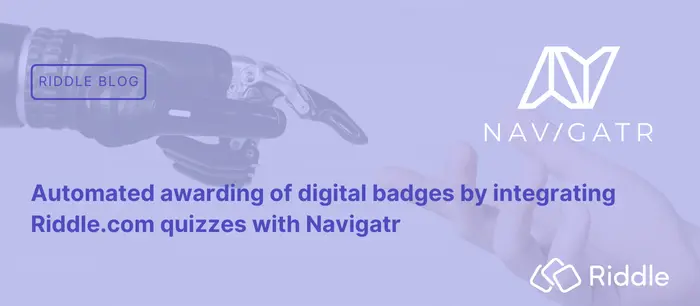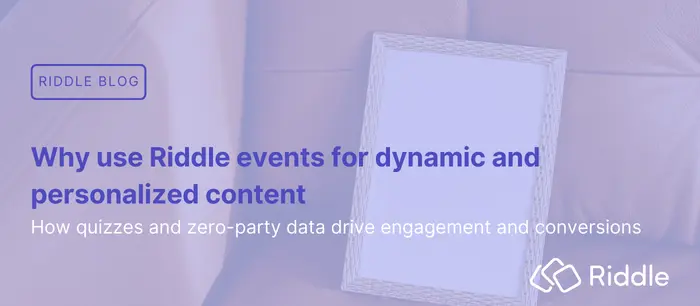How to optimize your online quiz
Good Quizzes are great for engaging visitors, increasing time on site, or monetizing your content through ads and sponsorship. People love to answer questions, and it’s a natural place to collect emails with lead generation. Riddle serves over 3 billion quiz questions per year, and we are happy to share our best practices to make a good quiz.
Did you know, for example, that each person spends an average of 2 min 47 seconds on a quiz?
People love to discover new things about a subject or themselves and share them with their friends, which means more traffic to your site. Most importantly, quizzes are a great tool for lead generation; the act of answering questions turns passive participants into active ones. After answering questions, people are psychologically prepared to opt in to your lead form. We’ve seen up to 50% completion rates.
What’s a good quiz start percentage?
60-70% of people who land on the page with your embedded quiz should click on the first question and start.
Many factors can affect this of course, such as where your quiz is on the page. Is it prominently placed at the top or tucked away at the bottom of your page?
As a good general indicator, a start rate that is too low is a sign that you might need to improve your title and main image to attract visitors’ attention.
What’s a good quiz completion rate?
Once people answer your first quiz question, you should see at least 70% go on to finish it and see their results.
Whilst lead generation forms in quizzes are an incredibly valuable resource, they also naturally lower completion rates as the audience has to go through an extra step in your quiz. Inserting an optional lead form before displaying results reduces completion rates by 5–10%. Adding a mandatory lead form will drive this percentage down to 30% or lower.
There’s an art to creating a quiz that converts visitors to leads. We have 30+ years of combined quiz experience – and here’s what we’ve learned:
1. Shorter titles
Choosing the right title for your quiz is important. It needs to catch the casually browsing visitor’s attention, and intrigue them enough to want to click and answer questions.
- It’s all about you: Make your quiz personal by using words like “you” or “your”.
- Use odd numbers in your title: Titles with odd numbers perform 20% better than round numbers like ‘Top 10’.
- Challenge your readers: Adding words like ‘the most’ or ‘actually’ make a test title an almost irresistible challenge.
- Eight words (or 60 characters): Research has found that titles with eight words have a 21% higher click through rate.
Here is a list of our 143 favorite quiz titles and online quiz examples.
2. Powerful images
A striking, well-chosen image will attract the audience’s eye as they scroll down your page.
- Fill the frame: Choose images that are less cluttered. On small screens like smartphones, simple images with less complicated compositions stand out much better.
- Quality: Make sure the images are clear and unpixelated, immediately making your quiz more professional.
- Be original: Use your own media if you have high-quality resources, and think about visuals that will grab your target audience’s attention.
- Creative common: There are a growing number of image libraries with a Creative Commons license, including Pexels and Unsplash.
3. Short & sweet
It’s easy to get caught up in writing lots of great questions. Keep in mind that people are busy and have increasingly short attention spans. We recommend staying within a range of three to four minutes to prevent a drop in quiz completions as people lose interest or are distracted by something else.
43% more people will complete an online quiz with six to ten questions than a 20-question one.
If you create a quiz for more serious topics like ‘Are you really depressed?’, you can go longer. People will be more emotionally invested in getting accurate results for health issues than in a lighter ‘entertainment’ quiz.
You could also add a timer to certain questions or the whole quiz to set a framework for your audience or add an element of adrenaline.
4. 50/50 rule
Invest as much effort and creativity in your quiz results as you do in your questions and quiz titles. The quiz results are your last chance to engage with your quiz takers and make an impression by demonstrating your expertise and insight into their responses.
Moreover, people often enjoy sharing the quiz or quiz results with others, so make sure the final thing they see – the result page – is memorable and professional.
5. Keep your lead forms short and make them optional
Quizzes are a powerful tool for lead generation. Since the quiz takers are already engaged in answering different questions, requesting their name and email can feel like a natural extension of the quiz rather than a typical lead generation form. However, asking for personal information can impact your quiz completion rates.
Make sure that any personal information requested is relevant to the quiz topic, and keep it brief. To improve user experience, consider splitting the lead generation; ask for the name at the beginning and the email address just before revealing the results.
The best way to collect leads in quizzes is to keep forms optional but give a strong reason for them to complete them. Once someone completes your quiz lead generation form, they’ll express a strong ‘buying signal’.
To convert and keep quiz takers interested, automatically send out follow-up emails based on their online quiz results using Mailchimp, ActiveCampaign, or 3,000 other tools via Zapier.
6. Offer discounts or launch contests / raffles
People are understandably cautious about giving out their email addresses, which is why we suggest giving them a good reason.
You could create a contest to win anything from a discount to VIP tickets by setting up a raffle. Or you could simply offer something like “Receive your own custom analysis of your quiz results along with five tips on how to improve. Just leave your name and email.”
You can customize this approach to suit your business. Still, the core value proposition remains the same — you’re offering a valuable service in return for the user’s name and email.
7. Customize your quizzes
When people visit your site to take your quiz, you have a few seconds to make them comfortable with your site’s look, feel, and branding.
The goal is to make your site as reassuring as possible to engage with your quiz. That’s where your design comes in:
- Take the time to use styling and formatting settings for your quiz as a whole and/or for each block.
- Customize the colors and fonts to match your brand.
- Make use of custom CSS to make your quiz feel like a seamless, natural part of your site.
8. Try different quiz types
Variety is key. Quizzes are most effective when used strategically.
The goal is to create quizzes that feel special and make your audience eager for the next one.
By incorporating a range of interactive content, such as polls, personality quizzes, and predictors, you not only add value to your website but keep your audience engaged and excited for future creations.
As an example, check out how Tate Modern uses quizzes to engage their kids and teen audiences around all things art. The style, topic, and format of each test is always different.
9. What others are doing
Check out our case studies to learn how others are using Riddle quizzes to engage users, generate leads and increase online sales.



